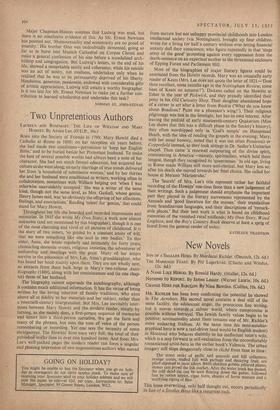Two Unpretentious Authors
LAURELS AND ROSEMARY. THE LIFE OF WILLIAM AND MARY
Howirr. By Amice Lee. (O.U.P., 30s.)
BORN into the Society of Friends in 1799, Mary Howitt died a Catholic at Rome in 1888; on her reception six years before, she had made two conditions—permission to 'keep her English Bible,' and to be buried beside her Protestant husband. To make the best of several possible worlds had always been a note of her character. She had not much formal education, but acquired her culture as she went along; an early marriage of true minds delivered her from 'a household of submissive women,' and by her thirties she and her husband were established as writers, working often in collaboration, sometimes with William helping out 'when I was otherwise unavoidably occupied.' She was a writer of the same kind, though not the same level, as Mrs. Gaskell, whose genius, Henry James said, was 'so obviously the offspring of her affections, feelings, and associations.' Reading 'talent' for 'genius,' that could stand for Mary Howitt.
Throughout her life she hoarded and recorded impressions and memories. In 1845 she wrote My Own Story, a work now almost unknown (and not mentioned by this biographer), though it is one of the most charming and vivid of all pictures of childhood. It is the story of two sisters, `so guided by a constant amity of will, that we were something like one soul in two bodies.' To this sister, Anna, she wrote regularly and intimately for forty years, chronicling domestic events, religious anxieties, the adventures of authorship and meetings with the great. Many of her letters survive in the possession of Mrs. Lee, Anna's granddaughter, who has based her book mainly upon them. They are not wholly new, as extracts from them bulk large in Mary's two-volume Auto- biography (1889), along with her reminiscences and (in one chap- ter) those of her husband.
The biography cannot supersede the autobiography, although it contains much additional information. It has the virtue of being written by the loving inheritor of family traditions, who aims above all at fidelity to her materials and her subject, rather than a twentieth-century interpretation. But Mrs. Lee inevitably inter- poses between Mary Howitt and the modern reader, simply by turning, as she mainly does, a first-person sequence of memories and letters into a third-person narrative. We get the facts and many of the phrases, but miss the tone of voice of the person remembering or recording. Yet one sees the necessity of some abridgement. The Howitts' lives were very full; the total of their published works runs to over two hundred items. And from Mrs. Lee's well-packed pages the modern reader can form a singular and pleasing impression of two unpretentious authors who moved from narrow but not unhappy provincial childhoods into London intellectual society (via Nottingham), brought up four children, wrote for a living for half a century without ever letting financial anxiety dull their conscience; who figure repeatedly in that 'stage army of the good' protesting against every oppression from the death-sentence on an expectant mother to the threatened enclosure of Epping Forest and Parliament Hill.
Most of the biographies of major literary figures could be annotated from the Howitt records. Mary was an unusually early reader of Keats (Mrs. Lee does not quote the letter of 1821—`Dost thou recollect, some months ago in the Nottingham Review, some lines of Keats on autumn?'). Dickens called on the Howitts at Esher in the year of Pickwick, and they proudly identified their pony in his Old Curiosity Shop. Their daughter abandoned hope of a career in art after a letter from Ruskin ('What do you know about Boadicea? Paint me a pheasant's wing!'). Their religious pilgrimage was less in the limelight, but has its own interest. After leaving the pinfold of early nineteenth-century Quakerism (Miss Lee shows that this was a difficult phase in the Society's history), they often worshipped only in 'God's temple' on Hampstead Heath, with the idea of reading the gospels in the evening; Mary, with her usual honesty, noted that it was too often Pendennis or Copperfield instead, so they took sittings in Dr. Sadler's Unitarian chapel. Then came 'a renewed outpouring of the divine spirit, commencing in America'—namely, spiritualism, which held them longest, though they recognised its 'queernesses.' In old age, living in Rome made William still more anti-clerical, but Mary less so; after his death she moved towards her final choice. She called her house at Merano `Marienruhe.'
The 'laurels' of Mrs. Lee's title represent rather her faithful recording of the Howitts' one-time fame than a new judgement of their writings. Such a judgement should emphasise the important part they played in the literary movements represented by the Annuals and 'good literature for the masses,' their translatibns from Scandinavian languages, and their descriptions of 'remark- able places.' But their best work is what is based on childhood memories of the vanished rural midlands; My Own Story, Wood Leighton, and the Boy's Country Book deserve at least a sprig of laurel from the general reader of today.
KATHLEEN TILLOTSON


































 Previous page
Previous page